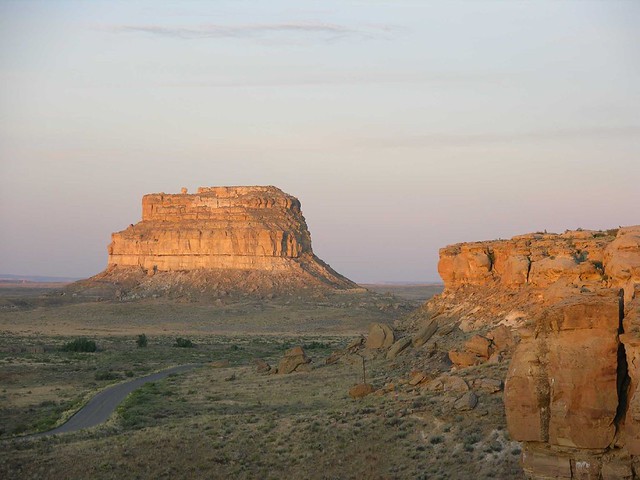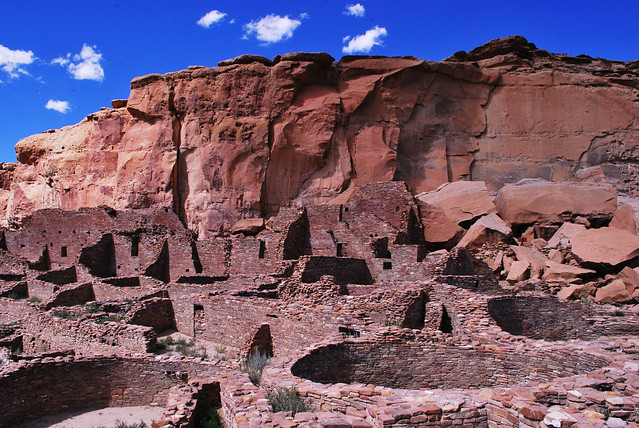Most people think that US National Parks and UNESCO World Heritage sites would be buffered from industrial extraction like fracking for oil. But during the last two weeks of May, we were at Earthworks were forced to think again and reconsider if that assumption is true.
 Photo by John FiveashThe Bureau of Land Management is amending its land management plan to flitate oil and gas development in the San Juan Basin that’s home to the Chaco Canyon National Historic Park.
Photo by John FiveashThe Bureau of Land Management is amending its land management plan to flitate oil and gas development in the San Juan Basin that’s home to the Chaco Canyon National Historic Park.
The Bureau of Land Management (BLM) is writing a new management plan for a multi-million acre swatch of public lands in northwestern New Mexico. Contained within this area is the treasured Chaco Canyon National Historic Park. One of less than a dozen UNESCO sites in the western United States, Chaco Canyon includes the ruins of what were the largest buildings in North America 1,000 years ago.
The hub of the Chacoan society is a series of well designed villages that at one point housed some 6,000 people who navigated the surrounding countryside using perfectly straight roadways etched into the landscape. Chaco Canyon is called the “American Cradle of Civilization,” and the descendants of the Chaco culture include several modern Southwest tribal nations. The Chaco ruins are considered sacred sites by the Navajo, Hopi and Pueblo peoples.
The Chacoans, of course, didn’t know that their communities were built atop the Mancos Shale, or that one day the US government would prioritize oil over culture and communities.
The BLM plan is being amended to help facilitate oil and gas development — particularly fracking — in the San Juan Basin. In response, Earthworks and partners took action, sending alerts through our networks encouraging the boss of the BLM — Interior Secretary Sally Jewell — to use her authority to protect the lands surrounding Chaco Canyon from oil and gas development. In just a few weeks, 173,000 people took action, flooding the BLM’s inboxes, as well as those of other lawmakers within the region, with a simple message: “protect these unique places from oil and gas development.”
 Photo by John/FlickrThe Chaco Canyon is called the “American Cradle of Civilization,” and the Chaco ruins are
Photo by John/FlickrThe Chaco Canyon is called the “American Cradle of Civilization,” and the Chaco ruins are
considered sacred sites by the Navajo, Hopi and Pueblo peoples.
This powerful video from the Solstice Project describes exactly why fracking should be halted in the region. The Chaco ruins do not stop at the Park’s boundaries; in fact, today’s protected area was merely the center of an enormous Anasazi world. Some 35 Chacoan Great Houses in the region are unprotected, and could be threatened by fracking. Archaeologists have not properly surveyed many of the ancient roadways. But in a familiar echo of the Obama administration’s “all of the above” energy policy, the BLM has already leased much of the surrounding landscape to oil and gas companies. If fracking consumes these cultural treasures, they could be lost forever.
Chaco is visited by tens of thousands of tourists every year who travel there — not to see fracking pads, rigs, pipelines, flares, and massive storage tanks — but to see the landscape closer to what it may have looked like when the Chacoans lived there.
This campaign is just beginning; the BLM will now take our comments and draft a plan, giving us another chance to pressure the agency, and more time to protect the Chaco region from fracking. We thank each and every one of the 173,000 people who spoke up to tell the BLM that prioritizing oil over culture and communities is not acceptable. Together, we will work to prevent Chaco from becoming another example of a special place getting fracked for short term gain.
For more information:
Santa Fe New Mexican: New oil boom coming to San Juan Basin
US Bureau of Land Management: Farmington Resource Management Plan Amendment
Written on the Landscape: Mysteries beyond Chaco Canyon
Background on history to protect Chaco and environs from San Juan Citizens Alliance
We don’t have a paywall because, as a nonprofit publication, our mission is to inform, educate and inspire action to protect our living world. Which is why we rely on readers like you for support. If you believe in the work we do, please consider making a tax-deductible year-end donation to our Green Journalism Fund.
Donate